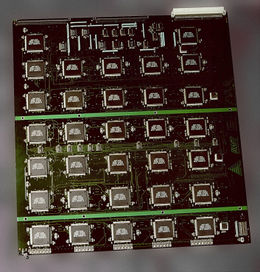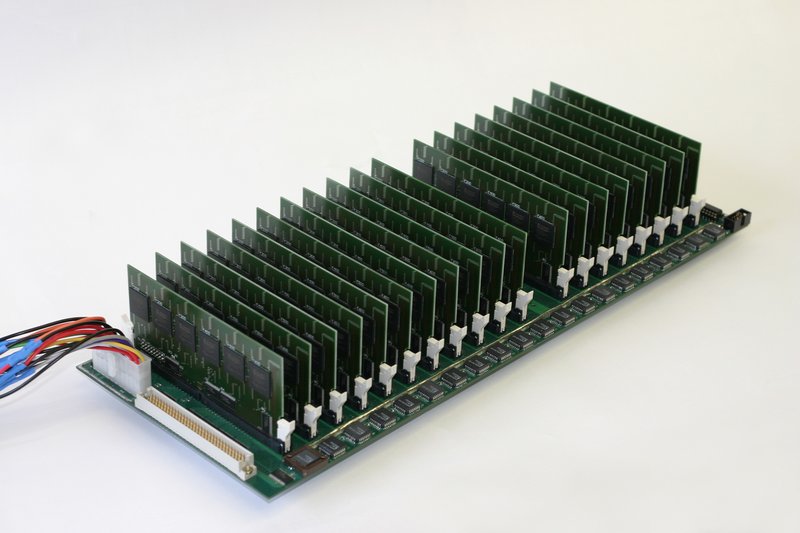Brute force attack
2007 Schools Wikipedia Selection. Related subjects: Cryptography
In cryptanalysis, a brute force attack is a method of defeating a cryptographic scheme by trying a large number of possibilities; for example, exhaustively working through all possible keys in order to decrypt a message. In most schemes, the theoretical possibility of a brute force attack is recognized, but it is set up in such a way that it would be computationally infeasible to carry out. Accordingly, one definition of "breaking" a cryptographic scheme is to find a method faster than a brute force attack.
The selection of an appropriate key length depends on the practical feasibility of performing a brute force attack. By obfuscating the data to be encoded, brute force attacks are made less effective as it is more difficult to determine when one has succeeded in breaking the code.
Symmetric ciphers
For symmetric-key ciphers, a brute force attack typically means a brute-force search of the key space; that is, testing all possible keys in order to recover the plaintext used to produce a particular ciphertext.
In a brute force attack, the expected number of trials before the correct key is found is equal to half the size of the key space. For example, if there are 264 possible keys, a brute force attack would, on average, be expected to find a key after 263 trials.
For each trial of a candidate key the attacker needs to be able to recognise when he has found the correct key. The most straightforward way is to obtain a few corresponding plaintext and ciphertext pairs, that is, a known-plaintext attack. Alternatively, a ciphertext-only attack is possible by decrypting ciphertext using each candidate key, and testing the result for similarity to plaintext language — for example, English encoded in ASCII.
In general, a symmetric key cipher is considered secure if there is no method less expensive (in time, memory requirements, etc) than brute force; Claude Shannon used the term "work factor" for this.
Symmetric ciphers with keys of length up to 64 bits have been broken by brute force attacks. DES, a widely-used block cipher which uses 56-bit keys, was broken by custom hardware in 1998 (see EFF DES cracker), and a message encrypted with RC5 using a 64-bit key was broken more recently by Distributed.net. More recently, the COPACOBANA (Cost-Optimized Parallel COde Breaker) was built, which is a reconfigurable code breaker that is suited for key searching of many different algorithms, including DES. In addition, it is commonly speculated that government intelligence agencies (such as the U.S. NSA) can successfully attack a symmetric key cipher with long key lengths, such as a 64-bit key, using brute force. For applications requiring long term security, 128 bits is, as of 2004, currently thought a sufficient key length for new systems using symmetric key algorithms. NIST has recommended that 80-bit designs be phased out by 2015.
If keys are generated in a weak way, for example, derived from a guessable- password, it is possible to exhaustively search over a much smaller set, for example, keys generated from passwords in a dictionary. See password cracking and passphrase for more information.
Ciphers with proven perfect secrecy, such as the one-time pad, can not be broken using brute force.
Theoretical limits
There is a physical argument that a 128 bit key is secure against brute force attack. It is argued that, by the laws of physics, in order to simply flip through the possible values for a 128-bit key (ignoring doing the actual computing to check it), one would need a device consuming at a minimum 10 gigawatts (about the equivalent of eight large, dedicated nuclear reactors) running continuously for 100 years. The full actual computation—checking each key to see if you have found a solution—would consume many times this amount.
However, this argument assumes that the register values are changed using conventional set and clear operations which inevitably generate entropy. It has been shown that computational hardware can be designed not to encounter this theoretical obstruction: see reversible computing.
A more pragmatic approach to increasing the computational efficiency per unit of power utilized involves the recent trends toward multi-core processor technologies. Multi-core processors are able to boost computational performance for many types of computations while minimizing power utilization. (which would include the kind of computations required for cryptanalysis using brute force techniques) Though the current state of this technology is far from providing the reversible computatitive capability that would be required to make a brute force attack of a 128 bit key feasible, future innovations may significantly improve the estimated crack time and power requirements. This becomes more likely as multi-core processors are combined into innovative SMP (symetrically multi processor) architectures that by using well designed algorithms, optimize utilization of each core per unit of power across a massive array of processors.
Some codes are provably unbreakable by brute force
Certain types of encryption, by their mathematical properties, cannot be defeated by brute force. An example of this is one-time pad cryptography, where every bit has a corresponding key bit. A brute force attack would eventually reveal the correct decoding, but also every other possible combination of bits, and would have no way of distinguishing one from the other.
A small 100 byte one-time pad encoded string given to brute force would eventually reveal every 100 byte string possible, including famous quotes, peoples names, and undiscovered wisdom, but mostly nonsense.

